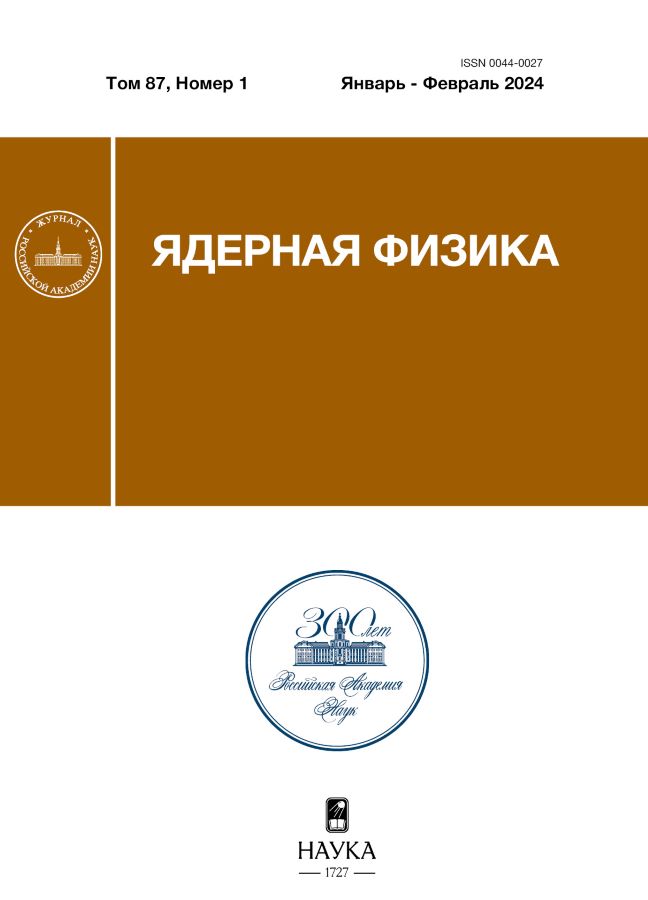Rare top-quark decay
- Autores: Slabospitsky S.R.1
-
Afiliações:
- NRC “Kurchatov Institute” — IHEP
- Edição: Volume 87, Nº 1 (2024)
- Páginas: 11-17
- Seção: ЭЛЕМЕНТАРНЫЕ ЧАСТИЦЫ И ПОЛЯ. Эксперимент
- ##submission.datePublished##: 03.10.2024
- URL: https://cardiosomatics.ru/0044-0027/article/view/674668
- DOI: https://doi.org/10.31857/S0044002724010028
- EDN: https://elibrary.ru/KEPEOG
- ID: 674668
Citar
Texto integral
Resumo
The calculation of the rare t-quark decay within the Standard Model as well as the charged Higgs contribution to this decay is presented. The role of possible background processes is discussed.
Texto integral
Sobre autores
S. Slabospitsky
NRC “Kurchatov Institute” — IHEP
Autor responsável pela correspondência
Email: Sergey.Slabospitsky@ihep.ru
Rússia, Protvino
Bibliografia
- Beneke et al., in Workshop on Standard Model Physics (and more) at the LHC (First Plenary Meeting) (2000), p. 419, hep-ph/0003033.
- P. A. Zyla et al. (Particle Data Group), PTEP 2020, 083C01 (2020), https://pdg.lbl.gov/
- V. D. Barger and R. J. N. Phillips, Collider Physics, Vol. 71 (Addison-Wesley, 1987).
- G. C. Branco, P. M. Ferreira, L. Lavoura, M. N. Rebelo, M. Sher, and J. P. Silva, Phys. Rept. 516, 1 (2012), arXiv:1106.0034.
- A. G. Akeroyd et al., Eur. Phys. J. C 77, 276 (2017).
- A. Arbey, F. Mahmoudi, O. Stal, and T. Stefaniak, Eur. Phys. J. C 78, 182 (2018), arXiv:1706.07414.
- G. Abbiendi et al. (ALEPH, DELPHI, L3, OPAL, LEP Collabs.), Eur. Phys. J. C 73, 2463 (2013), arXiv:1301.6065.
- T. Aaltonen et al. (CDF Collab.), Phys. Rev. Lett. 103, 201801 (2009), arXiv:0906.1014.
- V. M. Abazov et al. (D0 Collab.), Phys. Lett. B 710, 569 (2012), arXiv:1112.5431.
- M. Aaboud et al. (ATLAS Collab.), JHEP 1904, 046 (2019), arXiv:1811.12113.
- M. Aaboud et al. (ATLAS Collab.), JHEP 1809, 139 (2018), arXiv:1807.07915.
- G. Aad et al. (ATLAS Collab.), JHEP 2106, 145 (2021), arXiv:2102.10076.
- A. M. Sirunyan et al. (CMS Collab.), Phys. Lett. B 803, 135285 (2020), arXiv:1909.05306.
- A. M. Sirunyan et al. (CMS Collab.), Phys. Rev. D 102, 072001 (2020), arXiv:2005.08900.
- A. M. Sirunyan et al. (CMS Collab.), JHEP 2001, 096 (2020), arXiv:1908.09206.
- A. M. Sirunyan et al. (CMS Collab.), JHEP 2007, 126 (2020), arXiv:2001.07763.
- V. I. Borodulin, R. N. Rogalyov, and S. R. Slabospitskii, arXiv:1702.08246.
- S. R. Slabospitsky and L. Sonnenschein, Comput. Phys. Commun. 148, 87 (2002), hep-ph/0201292.
- E. Ma, D. P. Roy, and J. Wudka, Phys. Rev. Lett. 80, 1162 (1998), hep-ph/9710447.
- R. Decker, M. Nowakowski, and A. Pilaftsis, Z. Phys. C 57, 339 (1993), hep-ph/9301283.
- G. Mahlon and S. J. Parke, Phys. Lett. B 347, 394 (1995), hep-ph/9412250.
- E. E. Jenkins, Phys. Rev. D 56, 458 (1997), hep-ph/9612211.
- G. Altarelli, L. Conti, and V. Lubicz, Phys. Lett. B 502, 125 (2001), hep-ph/0010090.
- A. Papaefstathiou and G. Tetlalmatzi-Xolocotzi, Eur. Phys. J. C 78, 214 (2018), arXiv:1712.06332.
- P. Onyisi and A. Webb, JHEP 1802, 156 (2018), arXiv:1704.07343.
- N. Quintero, J. L. Diaz-Cruz, and G. Lopez Castro, Phys. Rev. D 89, 093014 (2014), arXiv:1403.3044.
- A. M. Sirunyan et al. (CMS Collab.), JINST 13, P05011 (2018), arXiv:1712.07158.
Arquivos suplementares
Arquivos suplementares
Ação
1.
JATS XML
2.
Fig. 1. Diagram describing the decay H+ → t*b → W+bb due to the contribution of the virtual t-quark.
Baixar (15KB)
3.
Fig. 2. Probabilities of H±-boson decays in three channels for four values of M(H+) masses as a function of tanβ (the mass values indicated are in GeV).
Baixar (303KB)
Baixar (70KB)
Baixar (80KB)
Baixar (27KB)
7.
Fig. 6. Diagrams describing the decay t → bbb +νl, in which the lepton pair +νl is not formed from a virtual W boson.
Baixar (39KB)
8.
Fig. 7. Diagrams describing the decay t → bbbcs, in which the cs pair is not formed from a virtual W boson.
Baixar (65KB)
9.
Fig. 8. Distribution of the invariant mass of the cs pair in the decay t → bbbcs. The sharp peak on the right corresponds to the decay of the virtual W boson into a pair of cs quarks. The wide part on the left corresponds to the contribution in which cs is not formed from the virtual W boson.
Baixar (54KB)


















